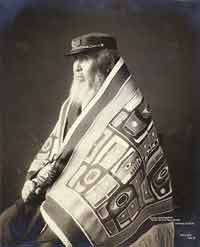Tlingit National Anthem
as
retold by Robert Willard Jr.
(Raven/Beaver Clan Elder)
This is the story of the Tlingit National
Anthem, a song that entwines our people with their past and
keeps our ancient heritage alive. At potlatch ceremonies,
Tlingit elders sing the anthem and tell how it came
about-for many years in secret, for this ritual was long
forbidden by the government-always passing the story on to
the new generations.
Long ago, the Tlingit Indians lived in the area now called
British Columbia and the Yukon Territory. They decided to
move from this region of lakes to the great ocean-now called
the Pacific-where they heard the fish were abundant. When
all of the clans had assembled, they began a great trek
through the mountain canyons leading to the sea.
After many, many miles, the way was blocked by a glacier
that filled the canyon. To go back in search of a different
route would be a long and wasting journey, so the leaders,
both women and men, climbed the mountain to look for a safe
way around the ice; there was none. But they saw a stream,
flowing from the narrow mouth of the glacier, which emptied
into a great bay on the distant side. The passage under the
glacier seemed too dangerous, the ice caverns too narrow to
pass through. Determined to continue the migration to the
ocean, the leaders met to plot a new course.

Then, four woman stepped forward and volunteered to journey
beneath the glacier. Two were barren, one was a widow, and
the fourth was well along in years. Because the women had no
children to nurture and protect, the leaders agreed to their
risky plan. So the men built a raft of logs and the woman
set forth early next morning. With renewed hopes the leaders
once again climbed the mountain, keeping watch all morning
and into the afternoon.
Toward evening, they heard distant voices calling from the
bay. It was the four woman, waving their arms and shouting
"We made it, we made it through, under the ice." Then, the
youngest and strongest of the Tlingits set out for the other
side. When they arrived, they began building large boats for
the next part of the journey, and explored the region beyond
the glacier for a safe place abundant in resources. Then,
all of the Tlingit people followed behind them. After three
days and three nights, they came through the ice caverns.
So, they set up camps and rested.
The next day, the people asked the great spirit to be with
them. They decided to row in all directions and settle as
much unoccupied territory as possible. It was a sad, sad day
as the people sang good-bye to their uncles and aunts and
cousins and friends. They wept as they rowed, but it was the
beginning of the Tlingit Nation, which today occupies more
than twenty-three million aces of land and water in
Southeast Alaska.
 Return to Indigenous Peoples' Literature
Return to Indigenous Peoples' Literature
Compiled by: Glenn Welker
This site has been accessed over 10,000,000 times since
February 8, 1996.